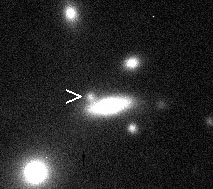| NGC 5177 | |
|---|---|
 NGC 5177 with SN 2010cr May 19, 2010 | |
| Observation data (J2000 epoch) | |
| Constellation | Virgo |
| Right ascension | 13h 29m 24.2s [1] |
| Declination | +11° 47′ 49″ [1] |
| Redshift | 0.021570 [1] |
| Heliocentric radial velocity | 6467 ± 29 km/s [1] |
| Distance | 297 Mly (Light Travel-Time) [1] (redshift-based) |
| Apparent magnitude (V) | 15.1g [1] |
| Characteristics | |
| Type | S0 [1] |
| Apparent size (V) | 0.81' x 0.46' [1] |
| Other designations | |
| MCG +02-34-019, PGC 47337 [2] | |
NGC 5177 is a lenticular galaxy in the constellation of Virgo. Based on a redshift of 6467 km/s the galaxy is crudely estimated to be about 300 million light-years away. [1]
Contents
On April 16, 2010 UT, the Palomar Transient Factory automated wide-field survey detected a supernova on the outskirts of NGC 5177. [3] The supernova is known as SN 2010cr [4] and is located at 13:29:25.11 +11:47:46.4. [3] A confirmation spectrum was taken with the Palomar Hale Telescope on April 17 UT which showed it to be approximately 13 days before peak brightness. [3] The Hubble Space Telescope took STIS/UV spectroscopic observations on May 3, 2010. [5]

